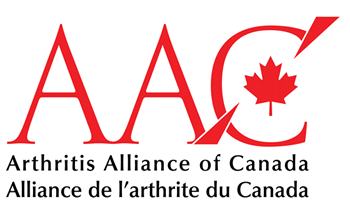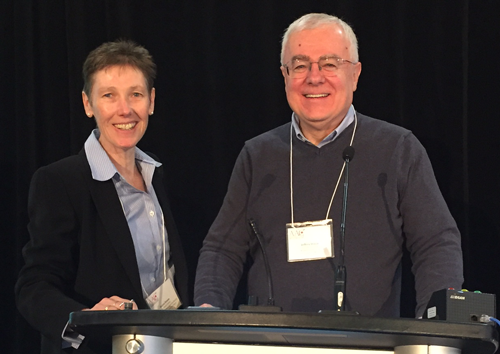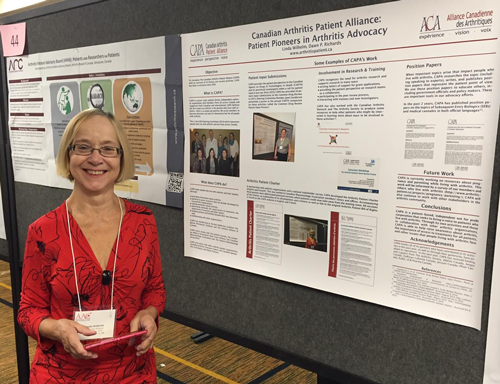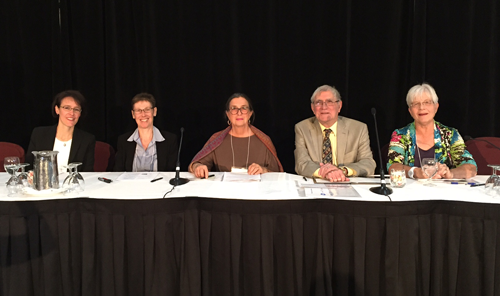Spring 2016 (Volume 26, Number 1)
New Directions in Osteoarthritis Research
By Deborah Marshall, PhD;
Kelsey H. Collins, PhD Candidate; and
S. Jeffrey Dixon, DDS, PhD
Download PDF

On October 22nd, 2015, the Arthritis Alliance of Canada (AAC) in partnership with the Canadian Institutes of Health Research (CIHR) Institute of Musculoskeletal Health and Arthritis (IMHA) brought together more than 200 arthritis stakeholders and leading experts in osteoarthritis (OA), including scientists, engineers, healthcare providers, trainees, specialists, and people living with arthritis. A research symposium entitled New Directions in Osteoarthritis Research identified knowledge gaps, highlighting research opportunities in OA and promising approaches for future studies. Presenters included a panel of engaged consumers (Ms. Alison Hoens, Mr. John Coderre, Ms. Anne Fouillard, and Dr. Jean Miller), and academic experts (Dr. Gillian Hawker, Dr. Frank Beier, Dr. Nicholas Mohtadi, Dr. Carolyn Emery, Dr. Linda Li, and Dr. Ewa Roos).

A key theme reflected in all presentations is the critical need for a paradigm shift across both basic and applied research; OA is not “just” the passive degeneration of cartilage resulting from wear and tear, but rather a complex illness of multiple tissues driven by the active participation of multiple cell types. Research has recognized OA as a heterogeneous condition with multiple pathogenic mechanisms and clinical manifestations delineating “OA phenotypes,” potentially requiring different diagnostic and therapeutic approaches. A transdisciplinary, team-based research approach across healthcare pillars is essential to describe, evaluate, and develop interventions for these subgroups of OA.
Evidence exists for the effectiveness of non-operative conservative care for knee OA, specifically for diet and exercise.1 We still do not have any disease-modifying drugs for OA analogous to biologics for inflammatory arthritis (IA); this remains a key research and translational opportunity. Additional research is also needed to explore the potential of regenerative medicine approaches for the prevention and treatment of OA.

Ms. Alison Hoens and Dr. Jeff Dixon presenting at the AAC Annual Meeting.
An exciting example of personalized treatment was described by
Dr. Roos, who studied exercise therapy personalized for OA patients to improve their joint function and reduce OA symptoms. This program, called Good Life with Osteoarthritis in Denmark (GLA:D),2 was successfully tested through a certification program for physiotherapists.
Dr. Li described how implementation of research knowledge continues to lag behind discovery, and that greater efforts are needed to translate our findings. This may involve capacity building in the fields of knowledge translation, implementation science, and patient engagement. An example presented by Dr. Emery was the recommendation to implement targeted injury prevention strategies in youth sport and recreation, where studies have shown a significant reduction in injuries with a neuromuscular training warm up.
The consumer panel highlighted the ongoing need to change the culture around patient engagement and emphasized the roles of patients. Such roles include identifying relevant research questions, aiding in the design of studies, interpreting findings, and translating knowledge, as well as working with other members of the OA community to advocate for adequate research funding.

Ms. Linda Wilhelm, Qualman-Davies Arthritis Consumer Community Leadership Award recipient, alongside her poster at the AAC Poster Session.
On the day following the symposium, AAC members, partners, and stakeholders met in a workshop format. Building on the outcomes of the symposium, goals of the workshop were to: Identify knowledge gaps in OA, synthesize and prioritize key research questions, and identify programs and strategies to tackle the most critical questions in OA research. A report detailing the conclusions from the symposium and workshop is presently in preparation.

(Left to right): Dr. Deborah Marshall, Ms. Alison Hoens, Ms. Anne Fouillard, Mr. John Coderre, and Dr. Jean Miller.
PowerPoint presentations from the research symposium and workshop are available on the AAC website; please visit www.arthritisalliance.ca/
en/aacannual/14-data-articles/173-2015-annual-conference-ppt to access this content.
References
1. Osteoarthritis Research Society International (OARSI). Physician Summary: Non-Surgical Treatment of Osteoarthritis of the Knee. 2014. Available at: www.oarsi.org/sites/default/files/
library/2014/pdf/physiciansumfinal.pdf.
2. Roos EM, Skou ST. English Summary: GLA:D Annual Report 2014. Available at: www.glaid.dk/pdf/English%20Summary%20annual%20report%202014%20GLAD.pdf.
Deborah Marshall, PhD
Arthur J.E. Child Chair,
Rheumatology Outcomes Research
Professor,
Department of Community Health Sciences,
University of Calgary
Director,
Health Technology Assessment,
Alberta Bone & Joint Health Institute
Calgary, Alberta
Kelsey H. Collins, PhD Candidate
Killam & CIHR Scholar
PhD Candidate in Biomedical Engineering,
Human Performance Laboratory,
University of Calgary
Calgary, Alberta
S. Jeffrey Dixon, DDS, PhD
Distinguished University Professor,
Co-Director,
Bone & Joint Institute
Western University
London, Ontario |

